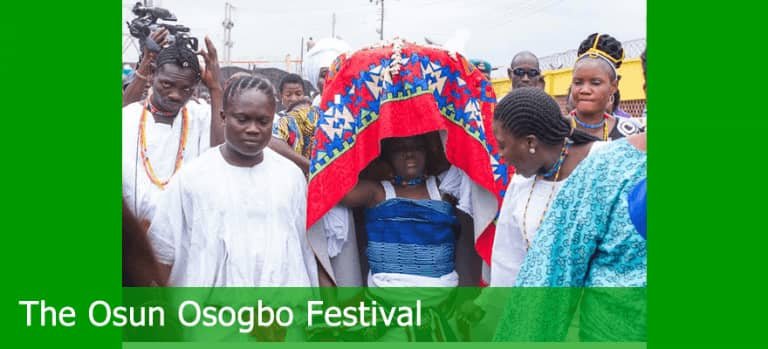Osun-Osogbo festival is celebrated every year, for two weeks in the month of August. This festival always takes place in the Osun-Osogbo Grove, which is a sacred forest along the banks of the Osun River just outside the city of Osogbo, Osun state, Nigeria. The site was inscribed as a UNESCO World Heritage Site in 2005. The festival has participants from all over the world especially from countries such as Brazil, Cuba, Trinidad and Tobago, Canada and Spain.
THE ORIGIN AND STORY OF OSUN FESTIVAL
The festival started over 700 years ago when a group of settlers led by one great hunter; Olutimehin settled on the bank of the river to escape the famine in their dwelling place. Osun, the river goddess was said to have appeared to Olutimehin and requested him and his group to move up a bit to a higher ground i.e. the present Osogbo (coined from Oso-igbo meaning spirit of the bush) town. Osun pledged to protect the group and make their women fruitful if they would offer an annual sacrifice to her in return. The group agreed, vowing to sacrifice annually to the goddess trusting that she would honor her promise. Today, the annual sacrifice has gone beyond offering sacrifices to a river goddess. The festival has become an international celebration of cultural events attracting people from all over the world.
HOW THE FESTIVAL IS CELEBRATED
Additionally, the festival which is a two-week-long event begins with ‘Iwopopo’. This is the traditional cleansing of the town from evil. After three days, the ‘Ina Olojumerindinlogun’ (16-point-lamp) which is 600-years-old is lighted. This is followed by the ‘Iboriade’, where all the crowns of the past kings or Ataojas (title of the king of Osogbo) are assembled for blessing by the sitting Ataoja of Osogbo, the Arugba (calabash carrier), the Yeye Osun (Osun priestess), and a committee of priestesses. The ‘Arugba’ is the key figure of the Osun-Osogbo festival. She is a votary virgin who bears the Osun calabash on her head. The calabash contains sacrifice for the goddess. The Arugba is also seen as a goddess as people pray and tell her all their problems as she leads them, with the calabash on her head to the river.

THE OSUN-OSOGBO GROVE
More so, the story of Osun-Osogbo festival includes the role of Susanne Wenger, an Austrian who worked towards its present development and to bring it to international attention. She remodeled the gods in sculpture and ceramics, and made over 75 cultural gods in artful representation. Wenger stopped people from abusing the integrity of the groves and prohibited hunting, fishing and felling of trees there. She personally rebuilt the customary shines and groves again until her death. The Osun-Osogbo Grove is now visited during the festivals by people from all walks of life and every part of the world.

